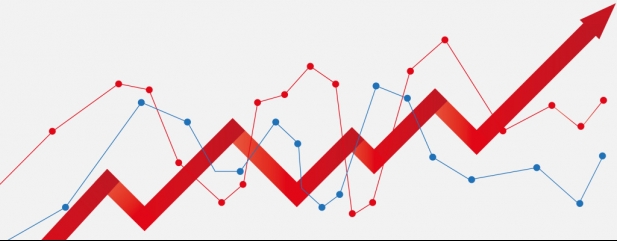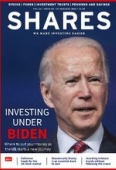Archived article
Please note that tax, investment, pension and ISA rules can change and the information and any views contained in this article may now be inaccurate.
The return of inflation

One theme which continues to exercise financial markets is whether inflation is primed to make a comeback and – if so – what this could mean for asset allocation and portfolio strategies.
The five-year forward inflation expectation in the US now stands at 2.11%, its highest level since December 2018, and financial markets are beginning to react: bond yields are ticking higher, bitcoin is going bananas while gold holds relatively firm. Within equity markets cyclical growth (or ‘value,’ for want of a better word) is again trying to cast off a decade of underperformance relative to perceived secular growth sectors such as technology.
As this column has suggested before, the battle for portfolio style (and performance) supremacy within equities can be seen by comparing the returns provided by two exchange-traded funds (ETFs) in the US: the QQQ Invesco Trust, which follows the price of the biggest non-financial stocks on the NASDAQ, and the Russell 2000 Value ETF.
If the line on this chart goes up, ‘growth’ is outperforming. If it goes down, ‘value’ is outperforming. As can be seen, cyclical growth outperformance stretches to summer 2020.
But this trend can be seen in another way too, this time on a geographic basis. Over the past decade, investors have adapted to the low growth, low inflation, low interest rate environment by buying long-dated assets such as bonds and equity growth (such as technology stocks), and forgetting about commodities, cyclical equities (‘value’) and emerging markets.
Yet as inflation creeps back onto the radar, perhaps for the first time in 40 years since then Fed chairman Paul Volcker set about wiping it out, emerging markets are coming back into fashion too.
This can be seen using the same technique as before, this time by dividing the performance of America’s S&P 500 index by the MSCI Emerging Markets benchmark. American outperformance peaked in September, since when emerging arenas have done better.
Clear pattern
This return to form for emerging markets coincides with a period of strength for commodity prices and dollar weakness. Whether it lasts may hinge to a great degree on those two trends, which also tie into the inflation narrative.
If those three continue to coincide, then we could see a third major period of emerging market outperformance relative to the US (and by implication developed markets), to match those of 1988-1994 and then 2000-2010, so this EM resurgence must be monitored closely. If it proves to be no mere flash in the pan, then it could have profound portfolio implications.
The resurgence of EMs can be seen by digging deeper into geographic performance trends, too.
Japan may be the best performer, in total return, sterling-denominated terms over the past 12 months, but Asia is a close second. The data from the past six months, when cyclical growth, or value, began to try and forge its latest comeback, show outperformance from not just Asia, but the Middle East and Africa, Latin America, and Eastern Europe, too.
East of Eden
Global export plays like South Korea and Taiwan have done well of late, but tourism and travel destinations like Thailand and Hong Kong are clear laggards. Perhaps South East Asia becomes the next leg of the post-vaccine, global upturn story.
There may be other reasons for the return to form of emerging markets, beyond commodity strength, dollar weakness and markets’ preoccupation with inflation and a near-term economic recovery, as this column hinted just under a year ago.
Perhaps Asia’s outperformance reflects the view that region was first in and first out when it comes to the global pandemic (even allowing for recent local flare-ups). Given the experience of SARS in 2002-03, Asia may have been better prepared and equipped to deal with such a situation.
In addition, Asian nations learned harsh lessons about debt during their currency crisis of 1997-98 and as a result aggregate government borrowing levels are generally much lower as a percentage of GDP than they are in the West.
Such facets could help to shape long-term outperformance too, especially as soundness of finances usually wins out in the end.
Important information:
These articles are provided by Shares magazine which is published by AJ Bell Media, a part of AJ Bell. Shares is not written by AJ Bell.
Shares is provided for your general information and use and is not a personal recommendation to invest. It is not intended to be relied upon by you in making or not making any investment decisions. The investments referred to in these articles will not be suitable for all investors. If in doubt please seek appropriate independent financial advice.
Investors acting on the information in these articles do so at their own risk and AJ Bell Media and its staff do not accept liability for losses suffered by investors as a result of their investment decisions.
Issue contents
Feature
First-time Investor
Great Ideas
- Experian reports reassuring growth
- Semiconductor cycle is turning to Micron’s advantage
- Polar Capital shares remain cheap despite high quality status
- Genus shares hit new record high after upgrading guidance again
- Knockout performance from Baillie Gifford US Growth
- Buy into Disney’s long-term dominance of the entertainment sector
Money Matters
News
- Major breakthrough for Netflix as it aims to be self-sustaining
- Three small cap new issues are currently flying high
- Investors buying IAG shares will have to pay new Spanish tax
- Shares in McDonald’s stall as challenges mount
- Shares in cruise operators start to rise as potential early vaccine beneficiaries
- High hopes for Bahamas Petroleum exploration well

 magazine
magazine








